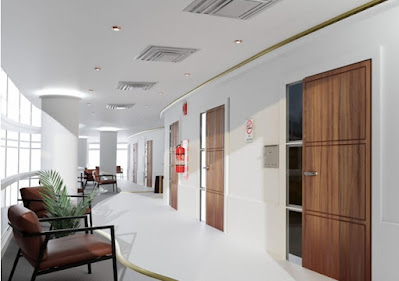5 Must-Have Features for Effective Room ID Signs
As a facility manager or business owner, one of your top priorities is ensuring that your guests have a positive experience. That means providing clear and concise directions to various areas in your facility, including rooms, restrooms, and emergency exits.
Room ID signs are a great solution to help with this task. Not only are they helpful for guests, but they are also required to be ADA compliant. With their raised letters and Braille, these signs are essential for those with visual impairments to navigate your facility independently.
But with so many options available in the market, how do you choose the right room signs for your facility? Which features are the most important? How do you ensure that they are ADA compliant?
In this article, we will explore five must-have features for effective room signs, and how they can help enhance the overall experience of your guests while ensuring compliance with the Americans with Disabilities Act (ADA).
Room ID Signs vs. Traditional Room Numbers: Which is Better?
One question that often arises when it comes to room identification signage is whether to go for traditional room numbers or room ID signs.
While traditional room numbers may seem like a simple and straightforward solution, there are several reasons why room ID signs may be the better option.
1. Improved Accessibility
Room ID signs offer improved accessibility for individuals with visual impairments. Unlike traditional room numbers, room ID signs often incorporate tactile features such as braille or raised lettering, making them easier to read and identify for those with visual impairments.
2. Customizability
Room ID signs offer more flexibility when it comes to customizing the signs to suit your specific needs. With traditional room numbers, you are limited to a basic number design that may not fit with your overall branding or interior design.
Room ID signs, on the other hand, can be customized to match your branding and interior design, creating a more cohesive and professional look.
3. Enhanced Wayfinding
Room ID signs can also enhance wayfinding for visitors and guests. By incorporating additional information such as room names or floor numbers, room ID signs can help guests navigate complex buildings or venues more easily, reducing the risk of confusion and frustration.
4. Durability
Room ID signs are typically made from more durable materials such as metal or acrylic, making them less likely to become damaged or worn over time.
For instance, metal signs are highly resistant to corrosion, making them ideal for outdoor use. They are also scratch-resistant, ensuring that they maintain their polished appearance for many years.
On the other hand, acrylic signs are less susceptible to damage than other types of plastic signs. They are highly resistant to UV light, making them ideal for outdoor use. Acrylic signs are also lightweight, making them easy to install and handle.
5. Overall Aesthetics
Room ID signs offer a more modern and stylish option for room identification, especially when compared to traditional room numbers. With a wide variety of design options available, including custom shapes and sizes, room ID signs can add a unique touch to any space and enhance the overall aesthetic appeal of your venue.
In the end, while traditional room numbers may be a simple and cost-effective solution for some, room signs offer several advantages when it comes to accessibility, customizability, wayfinding, durability, and overall aesthetics.
By investing in quality room signs, you can improve the experience of your guests and visitors, enhance your branding and interior design, and create a more professional and welcoming environment for all.
That said, let's cover some of the essentials when it comes to room ID signs.
5 Must-Haves in Your Room ID Signs
1. Clear and Visible Text
The text on your room ID signs should be clear and visible, even from a distance. This means using bold, easy-to-read fonts and contrasting colors.
The color contrast is especially important for those with visual impairments who may rely on color contrast to differentiate between elements on the sign.
When creating your sign, consider the distance at which it will be viewed and make sure the text is large enough to be easily read from that distance.
2. Braille and Tactile Lettering
Another essential feature of effective room ID signs is the inclusion of braille and tactile lettering. This is especially important for those with visual impairments who rely on touch to navigate unfamiliar spaces.
Braille and tactile lettering provide an added level of accessibility and inclusivity to your facility, ensuring that all guests can easily navigate and find their way around. When creating your sign, be sure to include raised lettering that can be easily read by touch.
3. Customization
Room ID signs can come in a variety of shapes, sizes, and materials. Customization is key to creating a sign that fits the unique needs of your facility. You may want to consider the overall aesthetic of your space when choosing the material and design of your sign.
For example, if you have a modern space, a sleek metal sign may be a good fit. If your space has a more natural feel, a wooden sign may be more appropriate.
Additionally, consider the size and placement of your sign. Will it be mounted on a wall or freestanding? Will it be placed indoors or outdoors? Customization ensures that your sign fits your specific needs and stands out as an integral part of your facility.
4. Durability
When it comes to creating effective room ID signs, durability is key. Your sign will be exposed to a variety of elements, including weather, temperature changes, and physical wear and tear.
A durable sign ensures that it will last for years to come, and you won't have to constantly replace or repair it. Consider materials such as aluminum or acrylic, which are known for their durability and longevity.
5. Easy Installation
Finally, an essential feature of effective room ID signs is easy installation. The last thing you want is a sign that is difficult or time-consuming to install. Your sign should come with all the necessary hardware and instructions for easy installation.
Consider the type of surface your sign will be mounted on and make sure the hardware is appropriate for that surface. Easy installation ensures that your sign can be quickly and efficiently put in place, saving you time and hassle.
In conclusion, room ID signs are a crucial element of any facility that wants to provide a smooth and hassle-free experience for their guests. They not only help with wayfinding and navigation, but they also add to the overall aesthetic of the space.
If you're looking for top-of-the-line room ID signs that are ADA-compliant, durable, and customizable, then check out our selection here at Braille Sign Pros.
With our years of experience and expertise in creating high-quality signs for a wide range of applications, you can trust us to create the perfect room ID signs for your facility.
Visit our website today to get started on creating custom room ID signs that meet all of your needs and exceed your expectations.






Comments
Post a Comment